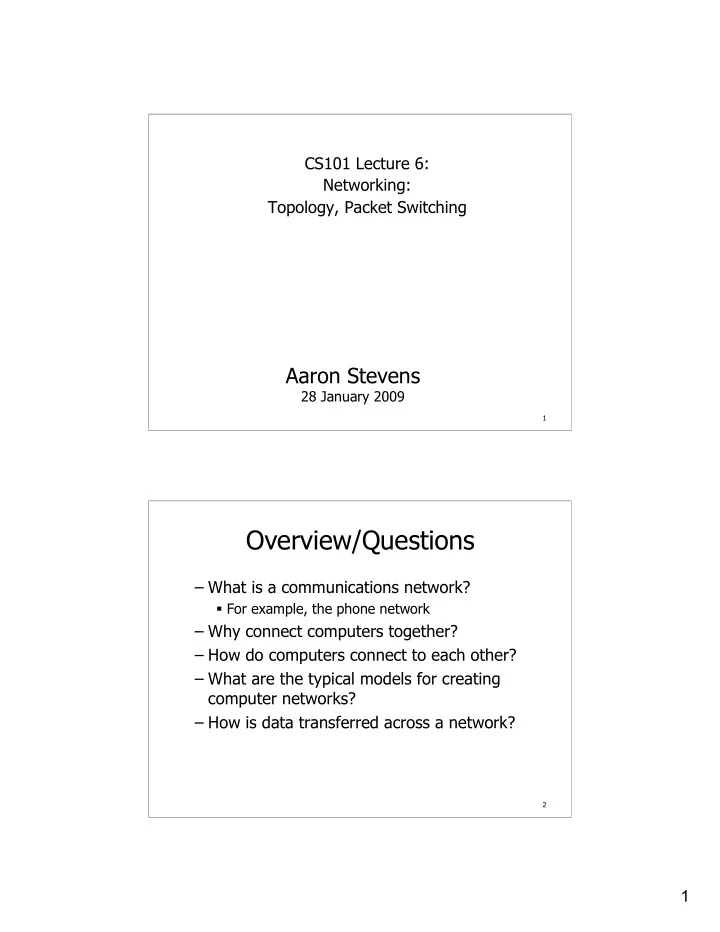

CS101 Lecture 6: Networking: Topology, Packet Switching Aaron Stevens 28 January 2009 1 Overview/Questions – What is a communications network? For example, the phone network – Why connect computers together? – How do computers connect to each other? – What are the typical models for creating computer networks? – How is data transferred across a network? 2 1
The Telephone Network POTS (the plain old telephone system), a.k.a PSTN To connect a phone call, the caller’s phone must be physically connected to connect to the receiver’s phone. Connecting thees circuits (called switching) takes place at dedicated facilities called central offices. POTS Circuit Switching Telephone wires leave your house, and connect to the central office. Image from www.exegesis.uklinux. net. At the central office, connections are made to other telephone lines… 4 2
POTS Circuit Switching Telephone operators used to actually switch wires to connect the calls. In the PSTN, this connection (called switching) is done electronically. 5 Computer Networking Computer Network A collection of computing devices connected in order to communicate and share resources. Connections between computing devices can be physical using wires or cables, or wireless using radio waves or infrared signals. Why connect computers together? 6 3
Clients and Servers Computer networks operate in a client/server model. Examples: – Browser / web server – File transfer client / FTP server 7 Networking Terms Client A computer which uses (consumes) resources from the network. Server A computer that stores and manages files or applications for multiple users on a network. Example: Web Server A computer dedicated to responding to requests (from the browser client) for web pages. 8 4
Network Nodes A network node is any device on a network: – Computer (desktop, laptop, PDA, etc.) – Server (web server, mail server, etc. ) – Router (device which directs traffic) – Firewall (access control device) 9 Modem Early computer networking used the phone network: dial up. A modem converts computer signals into sounds. 10 5
Network Interface Controller Each node has a network interface controller (NIC) connected to its circuit board. The CPU treats the NIC as an input/output device. It communicates by reading or writing bytes of data to the NIC. Each NIC has a unique Media Access Control (MAC) address, which distinguishes it from all other NICs. 11 Network Topologies Local-area Network (LAN) A network that connects a relatively small number of machines in a relatively close geographical area. Network Topology Describes the physical wiring plan for connections between nodes on a network. Also describes how messages are sent between nodes. 12 6
Ring Network Topology A ring network connects all nodes in a closed loop on which messages travel in one direction. – Each node has two neighbors How many hops? Complexity? Image source: http://www.edrawsoft.com/Network-Topologies.php Star Network Topology A star network centers around one node to which all others are connected and through which all messages are sent. How many hops? Complexity? Image source: http://www.edrawsoft.com/Network-Topologies.php 7
Bus Network Topology On a bus network nodes are connected to a single communication line that carries messages in both directions. How many hops? Complexity? Ethernet The industry standard bus technology for local-area networks. Image source: http://www.edrawsoft.com/Network-Topologies.php Types of Networks Local-area Network (LAN) A network that connects a relatively small number of machines in a relatively close geographical area. Wide-area network (WAN) A network that connects local-area networks over a potentially large geographic distance. Gateway/Router A particular computer on a LAN which directs all communication going between that LAN and other networks. 16 8
WAN Example LANs separated by a great distance are connected by High speed communication links to create a WAN. 17 Image source: http://www.air-stream.org.au/files/wide_area_network.gif Circuit Switched Network Computers can be connected over a circuit switched network (e.g. phone lines), creating a circuit between the source and destination. Image from www.tcpipguide.com. A Switched Circuit connects devices A and B. 9
Circuit Switching: Details – How many circuits do you need to connect 1 pair of computers? 2 pairs? N pairs? – What happens when a backhoe cuts the line? 19 Bursty Data Transmissions Computers send data in irregular bursts. Example: email. Using a switched network connection is wasteful – the circuits must be connected even if no data is being sent! 10
Packet Switching Packet A unit of data sent across a network. Packet switching Messages are divided into fixed-sized, numbered packets. Packets are individually routed to their destination, then reassembled into messages. Router A network device that directs a packet between networks toward its final destination. Packet Switching Network Nodes send packets of data along routes to a destination, without a dedicated circuit. Image from www.tcpipguide.com. Packets (even in the same transmission) can take different routes. 22 Image from http://www.teach-ict.com/technology_explained/packet_switching/packet.switching.gif 11
Packet Switching: Details – What happens to packets when they arrive? Are they ready for consumption? – What happens if some packet(s) get lost? 23 Advantages of Packet Switching – Efficient use of wires/circuits – Multiple paths between source and destination – Slow growth of network infrastructure as number of customers increases 24 12
Disadvantages of Packet Switching – Time required to reassembly messages, resend missing packets. Why does this matter? – Speed of delivery: latency is not guaranteed. – Inefficient for small packets. 25 Circuit or Packet Switching? – For which kind of information is circuit switching preferred? – For which kinds of information is packet switching preferred? – Are all packets treated the same by the network? Should some be prioritized? 26 13
Take-Away Points – Client-server model – LAN/WAN Topologies – Circuit Switching – Packet switching 27 Student To Dos – Readings this week: Reed ch 3, pp 44-50 (Wednesday) – Lab 03 on Thursday 1/29 is on HTML – Quiz 1 is on Friday 1/30 Covers material in lectures 1-4 – HW03 (HTML) due Tuesday 2/3 28 14
Recommend
More recommend